
Hundreds of thousands of Americans seek medical attention for burn injuries every year. These injuries often lead to a great deal of pain and trauma, particularly when they cause disfigurement.
The causes of these burns vary, from auto accidents to workplace accidents, and there are many types of burns. According to the American Burn Association, fires are the most common cause of burn injuries, followed by scalding.
Here is a full list of the most common types of burns:
Burns also vary a great deal in severity, ranging from damage to the outermost layer of skin to full-thickness burns. Below, we’re going to take a closer look at one of the most serious types of burn injuries – third-degree burns – including how they are diagnosed and treated.
If you suffered serious burns due to someone else’s carelessness, the burn injury lawyers at the Karl Truman Law Office can help. Contact us today for a free consultation in Kentucky or Indiana.
As stated above, there are four levels of burn injuries, from first-degree to fourth-degree:
In addition to these commonly recognized types of burns, another serious burn injury – the fourth-degree burn – is sometimes overlooked.
The worst type of burn is a fourth-degree burn, which is when the burn extends beyond the skin into the fat, muscles, tendons, and bones. There is no way to heal skin affected by a fourth-degree burn, and it almost always requires amputation.
Third-degree burns – also known as full-thickness burns – have a few unique signifiers that separate them from second-degree burns.
One of the clearest indications is when there is no pain since third-degree burns can destroy the affected nerve endings underneath the skin. The burn area will appear white, brown, or black. The skin may also appear dry and leathery, and there may be some swelling around the burn area.
Because of the severity of third-degree burns, new skin will not be able to grow in the area. Hence, third-degree burns usually require skin grafts.
There is also a high risk of complications with third-degree burns, particularly infections. For this reason, victims of third-degree burns often require treatment with IV antibiotics. These burns can also cause dehydration, requiring an IV to replace lost fluids. There is also the possibility that a third-degree burn will cause shock, sepsis, or organ failure.
Ultimately, the magnitude of a third-degree burn depends on what percentage of the body is affected and which parts of the body are affected. There is a positive correlation between how much of the body is burned and the mortality rate of burn victims.
While burns were often fatal in the past, most people now recover from third-degree burns. Nevertheless, there is a good chance of long-term scarring. Recovery from a third-degree burn generally requires therapy and an extensive period of healing.
Also, many victims of third-degree burns are affected psychologically by their injuries, especially when they result in permanent scarring. In addition, burn injuries can make it difficult to enjoy life as you once did, whether because of physical limitations or emotional and psychological effects.
While every burn injury is an unfortunate event, knowing that the injury could have been avoided if not for someone else’s negligence can make the accident that much worse. If you believe that one or more parties are at fault for the burn injuries you or a loved one has suffered, you may be entitled to compensation.
The Karl Truman Law Office has extensive experience representing clients in a wide range of personal injury claims. We thoroughly investigate to determine who is liable for your burn injury, build a strong case, and pursue full damages on your behalf.
Please contact the Karl Truman Law Office in Louisville, Kentucky, at (502) 222-2222 or in Jeffersonville, Indiana, at (812) 282-8500 today. Your initial consultation is free, and you only pay if our attorneys obtain a positive result in your case.